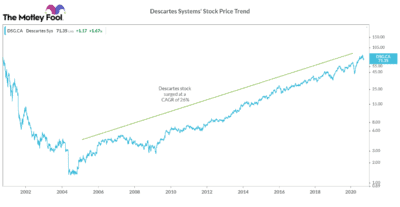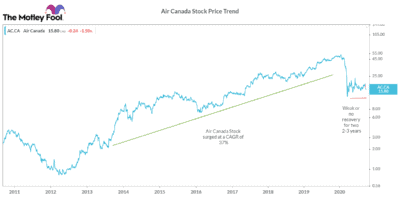Now that the Justin Trudeau government has upped the new recovery benefits to the level of the Canada Emergency Response Benefit (CERB), you should consider building your personal benefits pool. You can become a millionaire by putting as little as $100 a week in the right stock for 20 years. Just make sure that your shares generate an average annual return of 20%.
Stock market investing
No single stock can give you an average return of 20% for 20 years, unless it is Amazon or Apple. Investing in such stocks in their early stage is every investor’s dream, but it is difficult to say if the growth will continue or not.
20 years is a long time, and many companies close down during this time. One event can put even the market leaders out of business. Bombardier and BlackBerry are two examples. Bombardier was at its peak in 2000 and overcame the 9/11 crisis and the 2009 financial crisis. But it has not recovered from the 2014 product failure. Similarly, BlackBerry, which was once the market leader in phones, was disrupted by Apple’s iPhones.
Stock market investing comes with its risks, but it also rewards you well for taking these risks. Now, a good way to mitigate your risk is to diversify your portfolio. I don’t promote active investing, as it entails higher risk, but it is good to keep a check on the stocks in your portfolio and identify if the events are short-term headwinds or if they will have a lasting impact.
Here I will discuss two stocks and how the timing of their investment can make you a millionaire or leave you with losses.

Descartes Systems
Descartes Systems (TSX:DSG)(NASDAQ:DSGX) has been trading on the stock market since 1998. The company was among the early entrants in the software market and suffered from the dot.com bubble in 2000. Even after 20 years, the stock has not yet reached the 2000 level.
It was only in 2005 that the stock started to recover from the bubble. So, anyone who invested in Descartes when it showed growth benefitted from higher returns. From 2005 to 2020, the stock has surged at a CAGR of 26%.
If you invested in Descartes during the peak of the dot.com bubble and didn’t exit the stock, even when the bubble burst, you are still in the red. Now, instead of putting a lump sum amount in a high-growth stock, if you invest $400 every month, your risk would spread evenly.
Descartes has become a beneficiary of the e-commerce wave, which has increased the demand for its logistics solutions. And this trend is here to stay at least for the next two years until the economy recovers. Invest in the stock now, and then check on it after two years to see if the factors leading to its growth are still intact.
At present, Descartes’s future looks promising even after the economy recovers, as the demand from airlines and retail would return, and the e-commerce surge would have normalized a little. Remember, the objective is to get your overall portfolio’s annual return to 20%.

Air Canada stock
Another good stock in the last decade was Air Canada (TSX:AC). After bankruptcy and the 2009 financial crisis, the stock returned to growth in the second half of 2013. You don’t have to buy at the bottom. You just have to buck the long-term growth trend when you gain confidence in the company’s future growth. Even if you started investing in AC in 2014, the stock surged at a CAGR of 37%.
At present, AC is among the stocks disrupted by the pandemic. There is no recovery in sight for the airline before 2023. Hence, Air Canada, which was a millionaire-maker in 2014, is now a loss-maker. Instead of investing in AC, you can put your money in Cargojet, another beneficiary from the pandemic. While AC stock dipped 75%, Cargojet stock surged 80%. So, anyone who exited AC in April or May and put that money in Cargojet has recouped their loss.
If tracking your stock portfolio looks tiring, follow billionaire investors like Warren Buffett.







